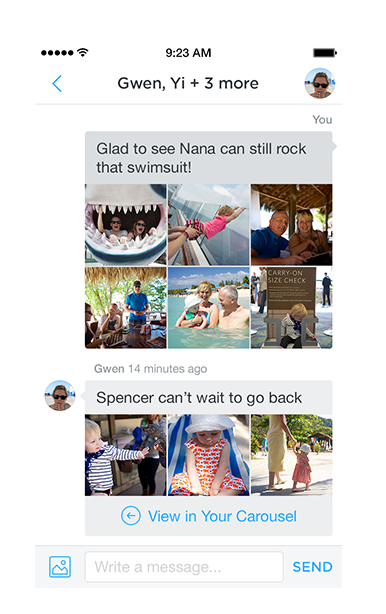Dropbox Sharpens Focus on Photos With New App
Dropbox, long known for its cloud-based file storage and sharing, is getting more organized, especially when it comes to images.

On Wednesday, the startup announced, among other things, a new app called Carousel that aims to make it easier to sort through and share the thousands of photos and videos many of us have stored on smartphones, computers, memory cards, and various photo-sharing services.
The app, along with changes to e-mail app Mailbox, which Dropbox bought last year, and to the Dropbox service itself, show the company is trying to branch out—perhaps in advance of an initial public offering, which is expected in the near future. Carousel is also Dropbox’s most significant move from file storage to file management and organization—the kinds of features normally associated with computer operating system.
Mailbox cofounder Gentry Underwood demonstrated Carousel during a mid-morning media event in San Francisco, calling it “a place where we can keep our entire lives’ memories with us at all times.” The app was expected to be available for Android smartphones and the iPhone on Wednesday.
Dropbox hopes that Carousel’s slick design, which mixes photos on your smartphone with those stored in Dropbox, will convince users to bring all their photos to the Web-based file-storage company—whether they’re sitting in a forgotten folder on your computer desktop or in a shoebox under the bed.
Dropbox founder and CEO Drew Houston said the company now counts 275 million users, up from 200 million late last year. No doubt plenty of them are already storing some photos in their Dropbox folders; the company had previously added a simple photo-viewing option to Dropbox.
The company has plenty of competition when it comes to collecting and sharing photos, though, both from large companies like Facebook (which also owns Instagram), Yahoo-owned Flickr, and a bevy of startups, so it will have to convince users why its app is worth their time.
Underwood did his best to demonstrate this as he scrolled through the app, which looks a bit similar to the default photo-organizing app on the iPhone, showing photos grouped by time and location. The app automatically uploads new images and videos you take to Dropbox—something you can already do with the Dropbox app—and lets you view local and remotely-stored ones together. At the bottom of the Carousel screen is a timeline—swiping left or right makes the app scroll to newer or older photos.
When users share images or groups of images with friends through the app, their friends can pick which photos they want to add to their own Carousel collection, which will sync them with their own Dropbox folders. Users can also send messages within the app to respond to photos that have been shared with them.
Aditya Agarwal, Dropbox’s head of engineering, said making it so that users could just scroll quickly through their timeline of images was one of the most difficult technical challenges in building the app. The company spent seven or eight months building Carousel, he said, and it took two to three months to get it to a point where users could scroll through images at 60 frames per second.
And while he acknowledged that there are plenty of other companies working on cloud-based image storage, he said people already use Dropbox a lot to store and share memories. The company’s current system of virtual folders isn’t the easiest to sift through, though.
“We can do better than that,” he said.
Keep Reading
Most Popular
Large language models can do jaw-dropping things. But nobody knows exactly why.
And that's a problem. Figuring it out is one of the biggest scientific puzzles of our time and a crucial step towards controlling more powerful future models.
How scientists traced a mysterious covid case back to six toilets
When wastewater surveillance turns into a hunt for a single infected individual, the ethics get tricky.
The problem with plug-in hybrids? Their drivers.
Plug-in hybrids are often sold as a transition to EVs, but new data from Europe shows we’re still underestimating the emissions they produce.
Stay connected
Get the latest updates from
MIT Technology Review
Discover special offers, top stories, upcoming events, and more.